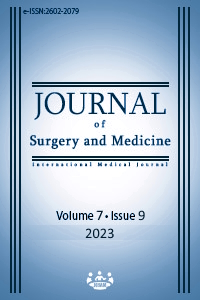Kite excision in complicated pilonidal sinuses: A retrospective cohort study of a tissue-sparing technique
Wide excision in complicated pilonidal sinuses
Keywords:
pilonidal sinus, complication, natal cleft, recurrence, surgeryAbstract
Background/Aim: Pilonidal sinus (PS) is a benign chronic condition that primarily affects young people and can have a significant impact on their social life and work. Treatment options range from minimally invasive methods to surgical interventions involving wide excision. This study evaluates the outcomes of Kite excision, which aims to preserve healthy tissues, in cases of complicated PS extending along the natal cleft line.
Methods: This retrospective cohort study included cases of complicated PS extending along the intergluteal sulcus. Patients with minimally extended PS, sinus openings extending laterally, or patients in whom the defect area was closed using other methods (e.g., rotation flap or Limberg flap) were excluded. Patient data were obtained from medical records and the hospital information system: patient age, gender, body mass index (BMI), length of hospital stay, duration of drainage, follow-up period, presence of flap necrosis or flap edema, wound dehiscence, and presence of seroma, hematoma, or surgical-site infections.
Results: A total of 41 patients were included in the study; five (12%) were female. Twenty-three patients (56%) had recurrent PS; 18 patients (44%) underwent surgery for the first time. The mean age of the cohort was 28.5 years (standard deviation: 5.1 years). The mean BMI of the group was 30.2 kg/m2 (standard deviation: 2.9 kg/m2), and the mean hospital stay was 1.3 days (standard deviation: 0.6 days). Wound dehiscence was observed in two patients (4.9%), and hematoma beneath the flap was observed in one patient (2.4%). Seroma was detected in one patient (2.4%). A surgical-site infection was identified in two patients (4.9%). The overall postoperative complication rate was 14.6%, and recurrence was observed in one patient (2.4%).
Conclusion: Kite excision performed along the natal cleft line in cases of complicated PS is a safe, effective, and minimally invasive procedure that preserves healthy tissues. It is a recommended surgical treatment option in cases of complicated PS with vertical extension, and it will reduce the incidence of recurrence and increase patient comfort.
Downloads
References
Turhan VB, Ünsal A, Öztürk D, Öztürk B, Buluş H. Comparison of excision and primary closure vs. crystallized phenol treatment in pilonidal sinus disease: A comparative retrospective study. J Surg Med. 2021;5(10):1007-10. doi: 10.28982/josam.1001636 DOI: https://doi.org/10.28982/josam.1001636
Ulusoy C, Nikolovski A. Factors affecting the success of crystallized phenol treatment in sacrococcygeal pilonidal sinus disease. Medicine (Baltimore). 2022 Dec 16;101(50):e31934. doi: 10.1097/MD.0000000000031934. DOI: https://doi.org/10.1097/MD.0000000000031934
Alkatta MA, Mejally A. Excision and tension-free primary closure of pilonidal disease. Turk J Surg. 2019 Dec 16;35(4):278-84. doi: 10.5578/turkjsurg.4368. DOI: https://doi.org/10.5578/turkjsurg.4368
Arer IM, Yabanoglu H, Caliskan K. Tension-free primary closure for the treatment of pilonidal disease. Ann Ital Chir. 2015;86:459-63.
Guner A, Boz A, Ozkan OF, Ileli O, Kece C, Reis E. Limberg flap versus Bascom cleft lift techniques for sacrococcygeal pilonidal sinus: prospective, randomized trial. World J Surg. 2013 Sep;37(9):2074-80. doi: 10.1007/s00268-013-2111-9. DOI: https://doi.org/10.1007/s00268-013-2111-9
Ozdemir H, Unal Ozdemir Z, Sunamak O. Complete natal cleft removal with kite incision in the treatment of extensive sacrococcygeal pilonidal sinus. ANZ J Surg. 2020 Apr;90(4):533-7. doi: 10.1111/ans.15550. DOI: https://doi.org/10.1111/ans.15550
Özdemir H, Ünal Özdemir Z, Tayfun Şahiner I, Şenol M. Whole natal cleft excision and flap: an alternative surgical method in extensive sacrococcygeal pilonidal sinus disease. Acta Chir Belg. 2014 Jul-Aug;114(4):266-70. DOI: https://doi.org/10.1080/00015458.2014.11681024
Bascom J, Bascom T. Failed pilonidal surgery: new paradigm and new operation leading to cures. Arch Surg. 2002 Oct;137(10):1146-50; discussion 1151. doi: 10.1001/archsurg.137.10.1146. DOI: https://doi.org/10.1001/archsurg.137.10.1146
Karydakis GE. Easy and successful treatment of pilonidal sinus after explanation of its causative process. Aust N Z J Surg. 1992 May;62(5):385-9. doi: 10.1111/j.1445-2197.1992.tb07208.x. DOI: https://doi.org/10.1111/j.1445-2197.1992.tb07208.x
Ertan T, Koc M, Gocmen E, Aslar AK, Keskek M, Kilic M. Does technique alter quality of life after pilonidal sinus surgery? Am J Surg. 2005 Sep;190(3):388-92. doi: 10.1016/j.amjsurg.2004.08.068. DOI: https://doi.org/10.1016/j.amjsurg.2004.08.068
Muzi MG, Milito G, Cadeddu F, Nigro C, Andreoli F, Amabile D, et al. Randomized comparison of Limberg flap versus modified primary closure for the treatment of pilonidal disease. Am J Surg. 2010 Jul;200(1):9-14. doi: 10.1016/j.amjsurg.2009.05.036. DOI: https://doi.org/10.1016/j.amjsurg.2009.05.036
Giuseppe F, Silvia DG, Patrizia R, Riccardo P, Antonio DS, Aldo RS, et al. Pilonidal sinus disease: Preliminary case-control study on heat-related wound dehiscence. Ann Med Surg (Lond). 2019 Aug 18;48:144-9. doi: 10.1016/j.amsu.2019.07.032. DOI: https://doi.org/10.1016/j.amsu.2019.07.032
Mentes O, Bagci M, Bilgin T, Ozgul O, Ozdemir M. Limberg flap procedure for pilonidal sinus disease: results of 353 patients. Langenbecks Arch Surg. 2008 Mar;393(2):185-9. doi: 10.1007/s00423-007-0227-9. DOI: https://doi.org/10.1007/s00423-007-0227-9
Akin M, Leventoglu S, Mentes BB, Bostanci H, Gokbayir H, Kilic K, et al. Comparison of the classic Limberg flap and modified Limberg flap in the treatment of pilonidal sinus disease: a retrospective analysis of 416 patients. Surg Today. 2010 Aug;40(8):757-62. doi: 10.1007/s00595-008-4098-7. DOI: https://doi.org/10.1007/s00595-008-4098-7
Kose E, Hasbahceci M, Tonyali H, Karagulle M. Comparative analysis of the same technique-the same surgeon approach in the surgical treatment of pilonidal sinus disease: a retrospective cohort study. Ann Surg Treat Res. 2017 Aug;93(2):82-7. doi: 10.4174/astr.2017.93.2.82. DOI: https://doi.org/10.4174/astr.2017.93.2.82
Al-Khayat H, Al-Khayat H, Sadeq A, Groof A, Haider HH, Hayati H, et al. Risk factors for wound complication in pilonidal sinus procedures. J Am Coll Surg. 2007 Sep;205(3):439-44. doi: 10.1016/j.jamcollsurg.2007.04.034. DOI: https://doi.org/10.1016/j.jamcollsurg.2007.04.034
Kanlioz M, Ekici U. Complications During the Recovery Period After Pilonidal Sinus Surgery. Cureus. 2019 Apr 19;11(4):e4501. doi: 10.7759/cureus.4501. DOI: https://doi.org/10.7759/cureus.4501
Downloads
- 290 555
Published
Issue
Section
How to Cite
License
Copyright (c) 2023 Zehra Ünal Özdemir
This work is licensed under a Creative Commons Attribution-NonCommercial-NoDerivatives 4.0 International License.
















